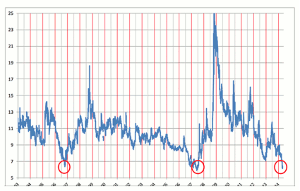Periods of low volatility in the forex market have historically been followed by periods of unusually higher volatility and the staff at Admiral Markets explains how the recent economic and geopolitical developments have all the right ingredients to illicit a change from low to high.
Higher volatility is a big celebration for short-term traders since it provides more trading opportunities. But, of late, lower volatility in the forex market has resulted in a lower amount of price movement in currency exchange rates. The slower market action has prevented traders from taking big positions in the market and forced them to remain on the sidelines.
However, historic evidence suggests that periods of extreme low volatility are often followed by unusually high volatility. Moreover, recent economic and geopolitical developments have all the ingredients to change the course of the prevailing no-volatility market condition. Hence, it becomes essential for traders to be prepared for confronting the risks of market turmoil and a possible sudden spike in the forex market volatility.
Recent comments by the Fed chairwoman Janet Yellen at Jackson Hole suggested that better-than-expected US labor market improvement would favor—possibly—an early move towards considering the first interest rate hike. Meanwhile, languishing Eurozone economic recovery forced ECB President Mario Draghi to hint towards adding further stimulus to boost economic recovery. Moreover, improving UK fundamental factors is also making BoE a strong contender to push for monetary policy tightening. In the current environment of ultra loose monetary policies by major central banks of developed economies, it would certainly be interesting to see how investors react to the diverging monetary policy outlook from major central banks. Volatility is bound to rise during the early stages of the tightening cycle, especially when it comes from the world's largest central bank.
Also, changes in the geopolitical developments could pose risks of triggering market volatility. Although, recent news suggests that a cease fire has been reached between Israel and Hamas, fading hopes for peace talks between Ukraine and Russia seem to extend the ongoing uncertainty surrounding the issue. The uncertainty could also fuel volatility, boosting demand for safe haven currencies, US dollar and Japanese yen.
Thus, a combination of geopolitical and monetary policy risks could be the initial trigger for rising volatility in the near-term.
Having discussed the probable event risks that might trigger volatility, it becomes crucial to discuss some important risk management strategies, which would help traders to secure their trades during higher market volatility.
- Risk no more than 3% of the account equity in a single trade. Novice traders should risk only 1% of the equity
- Set strict stop loss and target price before entering a trade
- Frequently review the market to get insight for existing trades
- Cultivate the habit of trailing the stop loss as, and when, opportunity arises
- Focus on executing the plan and measure the performance critically so as to avoid delayed and/or hasty trade decisions
Since higher volatility also stands for additional risk, traders should not forget to adhere to their risk management strategies in order to benefit from the expected rise in volatility.
By the staff of Admiral Markets












